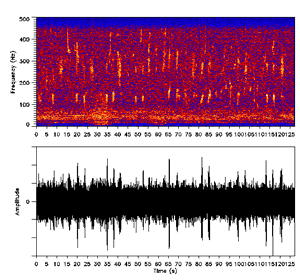Bioacoustics
Bioacoustics is the scientific study of the sound production, dispersion, and reception in animals, including humans. This interdisciplinary field combines biology and acoustics to understand how and why animals communicate with sound, the mechanisms of sound production, and the role of sound in the ecological and evolutionary processes. Bioacoustics encompasses research on all forms of animal life, from insects to marine mammals, and investigates a wide range of topics such as animal behavior, species identification, ecosystem health, and the impacts of noise pollution.
Overview[edit | edit source]
Bioacoustics involves the analysis of acoustic signals produced by animals, including their structure, function, and ecological significance. These signals can serve various purposes, such as attracting mates, deterring predators, navigating, or locating prey. Researchers in bioacoustics use a variety of tools and techniques, including microphones, hydrophones, and audio recording devices, to capture animal sounds. Advanced software is then used for sound analysis, helping scientists to visualize and interpret the complex patterns of animal communication.
Applications[edit | edit source]
The applications of bioacoustics are diverse and have significant implications for conservation biology, wildlife management, and environmental monitoring. For example, bioacoustic methods are used in:
- Species Monitoring: Identifying and monitoring species through their unique sounds, which is especially useful for nocturnal or elusive animals.
- Biodiversity Assessment: Assessing the health and diversity of ecosystems by analyzing the acoustic environment or soundscape.
- Behavioral Studies: Understanding the behavioral context of animal sounds, including mating rituals, territory defense, and social interactions.
- Noise Pollution Impact: Studying the effects of human-made noise on animal communication and behavior, which is critical for developing strategies to mitigate these impacts.
Challenges and Future Directions[edit | edit source]
One of the main challenges in bioacoustics is the vast amount of data generated from sound recordings, which requires substantial computational resources and sophisticated algorithms for analysis. The development of automated sound identification and classification systems is an area of active research, aiming to improve the efficiency and accuracy of bioacoustic studies.
Future directions in bioacoustics may involve the integration of artificial intelligence and machine learning techniques to handle the complexity of acoustic data. Additionally, there is a growing interest in exploring the potential of bioacoustics for understanding the effects of climate change on animal communication and for the development of new technologies inspired by animal sound production and reception mechanisms.
See Also[edit | edit source]
Navigation: Wellness - Encyclopedia - Health topics - Disease Index - Drugs - World Directory - Gray's Anatomy - Keto diet - Recipes
Search WikiMD
Ad.Tired of being Overweight? Try W8MD's physician weight loss program.
Semaglutide (Ozempic / Wegovy and Tirzepatide (Mounjaro / Zepbound) available.
Advertise on WikiMD
WikiMD is not a substitute for professional medical advice. See full disclaimer.
Credits:Most images are courtesy of Wikimedia commons, and templates Wikipedia, licensed under CC BY SA or similar.Contributors: Prab R. Tumpati, MD





